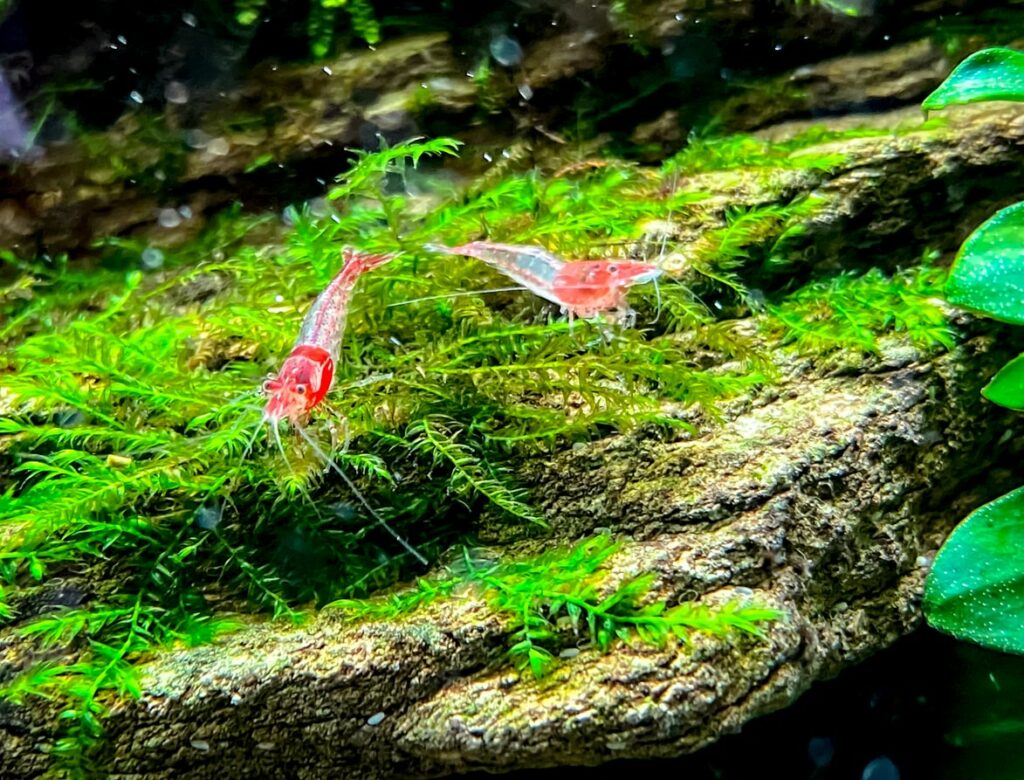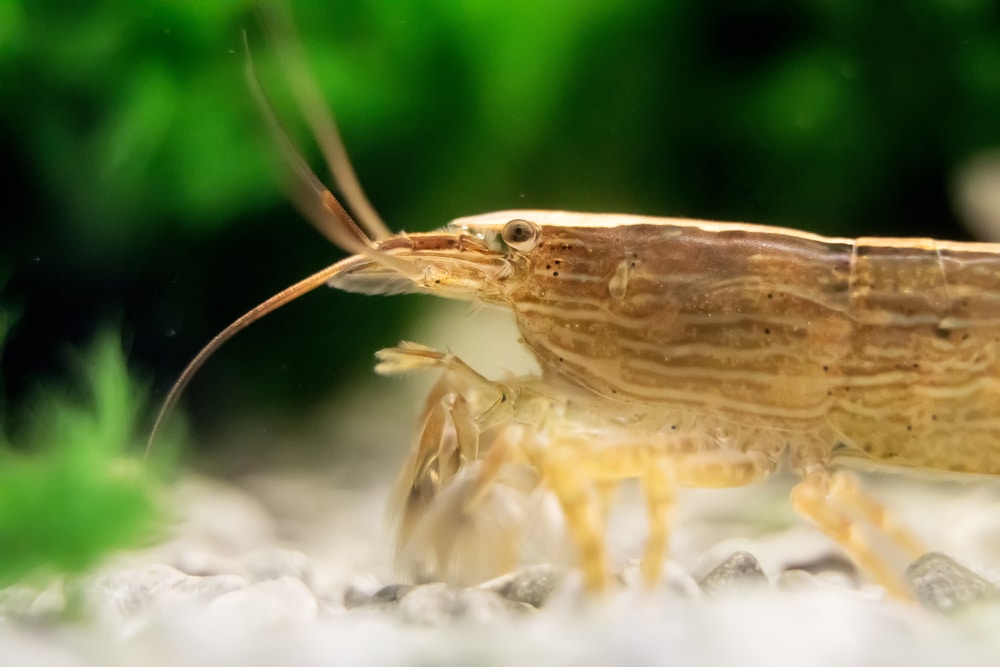Is It Ok to Feed My Fish Shrimp
BuildYourAquarium.com is supported by our readers. When you buy through links on our site, we may earn a commission. Learn more.
Fish (and humans) do love to eat shrimp. But what do freshwater shrimp eat? As it turns out, quite a lot of things. Like their other crustacean cousins, shrimp will eat nearly anything they can get ahold of. But some shrimp are much pickier eaters than others. Let's get to know shrimp and their meal habits below.
What Do Shrimp Eat?

Shrimp occupy the scavenger niche of the aquatic food chain. That is to say, they are like the roaches of the underwater world. Remember that the next time you're staring down a tasty plate of scampi or prawns.
Shrimp eat literally any kind of organic matter they can find on the ocean floor. But they prefer mostly animal protein, algae, and decaying vegetable matter. This makes them omnivores; creatures that eat both plant and animal fare.
Different freshwater shrimp have different preferences. But most shrimp species are entirely omnivorous. Many are also specialized in very particular diets.
Some ocean shrimp species are famous for being cleaners of fish, particularly saltwater cleaner shrimp. Pacific cleaner shrimp perch themselves on rock or coral outcroppings. You would think this would make them easy meals for passing fish.
Instead, they wave their antennae enticingly for passing fish to notice. Once a fish stops the shrimp then climbs right onto them and begins picking away at loose scales, dead skin, and parasites. They even climb into the wide-open mouths of toothy predators to scrub between their teeth.
Most freshwater shrimp have to be content with tiny prey items and the leftovers of bigger predators. Their claws are too tiny to get a good hold on animals that can fight back.
This makes aquarium shrimp the safest crustaceans to keep with small fish. Crayfish, crabs, and lobsters have heavier claws and stronger shells. They are much more willing to latch onto a small fish and begin eating.
However, a few freshwater prawns do have fairly large claws and heavier bodies. These tend to be Asian species of the genus Macrobrachium. Many can grow anywhere from 4-8 inches long.
While they are too slow and delicate to catch fast moving fish during the day at night they have a much easier time. Freshwater prawns can also be given blanched vegetables, earthworms, and other meaty fare to keep them well fed and non-aggressive.
Shrimp as Scavengers
Other shrimp tend to be less bold in their dining habits. Amano and Red Cherry Shrimp, two of the most popular freshwater species, eat mostly biofilms and algae. Biofilms are the coatings of micro organisms that develop on nearly any hard surface underwater.
You might be familiar with brown algae. This diatomaceous growth forms a thin brown coating over everything, even the glass. Unfortunately, shrimp don't find it tasty.
When keeping biofilm feeders, live plants, rocks, and driftwood tend to produce the healthiest biofilm "crops." Especially when given plenty of light and slow currents. So don't be too tidy when keeping shrimp, unless you intend on providing supplemental food.
Shrimp Eating Shrimp
Unfortunately, shrimp are so willing to eat just about anything that they may end up eating each other on occasion. Like all arthropods (crabs, lobsters, insects, spiders, centipedes, etc), shrimp need to molt on occasion.
Unlike us vertebrates, shrimp skeletons are external. While they are rigid, like armor, they can't grow along with the insides of the shrimp. Once shrimp molt, they can continue to grow but they are vulnerable for a few hours until the new shell hardens.
Soft and vulnerable, sometimes other shrimp may decide to pounce on their defenseless neighbor. Crayfish, crabs, and lobsters are especially willing to be cannibals as they have heavier claws that do more damage.
Still, a larger shrimp coming upon a newly molted, smaller cousin will gladly make a meal out of it if the shrimp is hungry enough.
Feeding Bamboo & Vampire Shrimp

Bamboo and vampire shrimp are special cases. Unlike most freshwater shrimp, they aren't scavengers of biofilms or cleaners. Instead, they use specialized limbs full of bristles to filter out floating particles of food.
Plankton, crushed flakes, and live or frozen items like baby brine shrimp and daphnia are all happily accepted by these specialized shrimp. Often you'll see them standing on plants or driftwood, aligned with the filter outflow.
Bamboo shrimp may even wrestle with one another over the best spot in the current, hoping to get lucky and snare some passing food. Vampire shrimp, on the other hand, aren't especially social and are mostly nocturnal. But at night, you'll still see them busily filtering the water for bits of floating food.
Both bamboo and vampire shrimp will still accept sinking pellets, flakes, and other items. But if you want to see them perform their natural behavior, try adding food directly to the water current instead.
Best Shrimp Food That We Recommend
Freshwater shrimp eat almost anything. But here are a few of our favorite shrimp foods:
Blanched Vegetables
Shrimp love plant matter but living plants are often too tough or bitter to be of much interest to them. Instead, take some frozen or chopped vegetables and parboil them for 5-10 minutes. This softens them up.
Terrestrial vegetables like zucchini, spinach, okra, and squash are all perfect. You want to choose vegetables that will get soft with a light boiling.
Once prepared (avoid seasoning), attach your vegetables to a feeding clip and place it near the bottom of the fish tank. Eventually, you'll find your shrimp gravitating towards it to graze. If you have enough shrimp they may even consume the entire offering in a single day.
Prepared Shrimp Food
Omnivorous shrimp are extremely cosmopolitan when it comes to eating. If it's organic they will eat it. Standard fish flakes and pellets are quickly snatched up. But if you're keeping specialty shrimp species like Bee Shrimp or some of the Sulawesi species, you may want to use a formula designed specifically for them.
These shrimp are quite sensitive and need both precise water conditions and a diet that provides them the micronutrients they need to keep their shells strong and growth constant.
Prepared shrimp food also contains a wide assortment of protein sources, from algae to fish meal. This ensures that these omnivores get the diversity they need.
Fresh and Frozen Meaty Food
Shrimp also love raw animal protein. Frozen foods like brine shrimp, bloodworms, and daphnia will all be greedily snatched up. You may even see your shrimp swimming around to try and find floating food or dead fish once they catch the scent with their antennae.
Live foods like tubifex and blackworms may be a bit more difficult. Shrimp tend to focus on one worm at a time, allowing the others to escape. A worm may also be too much for the tiniest of shrimp.
Still, as long as you don't mind them colonizing your gravel or you have more fish to eat them, it's not an issue if a few escape.
Conclusion
While they may look delicate, shrimp are problem-free when it comes to eating. So long as it came from either a plant or an animal, they will likely eat it. Just do your research before purchasing a new shrimp species as a few may have dietary needs you'll find challenging.
More Frequently Asked Questions About What Do Shrimp Eat +14
Are you still hungering for more information about what shrimp eat? Then take a moment to consider these frequently asked questions on the topic.
What Is A Shrimp's Favorite Food?
Shrimp will eat just about anything because they are scavengers and detritivores. A few freshwater shrimp eat more specialized items. Bamboo and vampire shrimp are specialized filter feeders. Others, like bee shrimp and red cherry shrimp, need biofilm or commercial shrimp food to survive.
Lightly boiled vegetables are another great food to feed freshwater shrimp. Zucchini, spinach, lettuce, and other greens just need a few minutes of softening in boiling water. After they cool down you can clip them in place inside of your fish tank.
What Do Shrimps Eat To Survive?
Since the majority of shrimp are scavengers they will eat whatever they can find. Commercial shrimp food is helpful if your aquarium fish do not leave any leftovers. But leftover and uneaten food are good for them to eat. Algae is also a big part of the shrimp diet. Even dead fish will be covered in shrimp if they are hungry.
What Do You Feed Bee Shrimp?
Bee shrimp eat mostly biofilm and a plant-based diet. Algae and decaying plants are some of their favorite foods. Bee shrimp don't eat much animal protein at all.
Do Crabs Eat Shrimp?
Wild shrimp are delicate animals and are prey to a lot of predators. Crabs will definitely eat shrimp because they have much more powerful claws. Even in your fish tank, a small crab is a threat to shrimp. Once it grabs them it can easily rip off legs, which can leave your shrimp unable to eat and leads to a dead shrimp.
Source: https://www.buildyouraquarium.com/what-do-shrimp-eat/

0 Response to "Is It Ok to Feed My Fish Shrimp"
Post a Comment